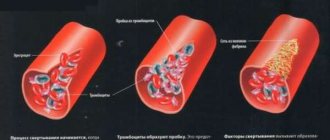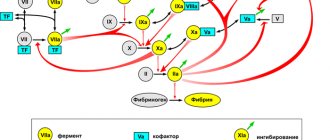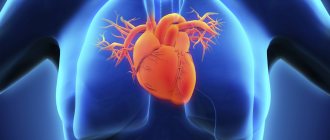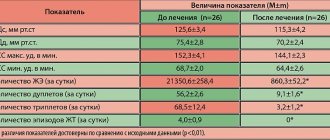This study is an identification of polymorphisms in genes associated with hereditary thrombophilia and other disorders of the blood coagulation system. Thrombophilia is an increased tendency to random (for no apparent reason) deep vein thrombosis and thromboembolic complications. Thrombosis can occur due to circulatory disorders (blood stagnation), increased ability of the blood to form blood clots (hypercoagulation), damage to the vascular wall, and a combination of these factors. Hypercoagulation may be due to the presence of a genetic predisposition to thrombophilia (the most common polymorphisms in the F2 and F5 genes), which this analysis can identify.
When do you need to take the THROMBOPHILIA extended test?
- Cases of hereditary thromboembolism in the family.
- History of thrombosis:
- single thrombosis before 50 years of age;
- repeated thromboses;
- a case of thrombosis at any age with a family history;
- thrombosis of unusual localization (portal, mesenteric, cerebral veins);
- thrombosis of unknown etiology after 50 years.
- High risk situations:
- massive surgical interventions;
- long-term immobilization;
- oncological diseases;
- chemotherapy.
- Ischemic stroke.
- Cardiovascular diseases.
- Prescription of standard antiplatelet therapy.
- Use of hormonal contraception or hormone replacement therapy.
- Planning pregnancy in women with a history of thrombosis, 1st degree relatives with diagnosed hereditary thrombophilia, or a family history of thromboembolic complications.
- Complicated obstetric history.
What do the test results mean?
As a conclusion, a genetic health card is issued, compiled by a professional geneticist in our laboratory. It presents the results of the analysis with interpretation, provides a detailed description of the studied polymorphisms and their impact on the risks of developing disorders of the blood coagulation system, cardiovascular diseases and pathologies of pregnancy, advice on conducting additional studies and detailed clinical recommendations for the attending physician.
The results of the analysis are interpreted by the attending physician. Based on them, the doctor can adjust the patient’s diet and lifestyle, prescribe medications and additional tests.
Detailed description of the study
A study of 12 genetic factors in the development of thrombophilia is used to assess the risk of thrombosis and other complications in people at risk.
The study includes analysis of 12 parameters:
- Coagulation factor II (F2 thrombin). Polymorphism: G20210A.
- Coagulation factor V (F5 Factor Leiden) Factor V Leiden (G1691A; Arg506Gln).
- Coagulation factor VII (proconvertin) F7: 10976 G>A (Arg353Gln).
- Coagulation factor XIII (F13A1). Polymorphism: Val34Leu (Val35Leu).
- Fibrinogen (Coagulation factor 1) FGB: G-455A (G-467A).
- Integrin, alpha 2 ITGA2: C807T.
- Integrin, beta 3 (platelet glycoprotein IIIa) ITGB3: PIA1/PIA2 (Leu33Pro; T1565C; HPA-1b).
- Plasminogen activator inhibitor SERPINE1 (PAI1). Polymorphism: 4G/5G (PAI1: 4G/5G; Ins/Del G).
- Methylenetetrahydrofolate reductase MTHFR: C677T (Ala222Val)
- Methylenetetrahydrofolate reductase MTHFR: A1298C (Glu429Ala)
- Methionine synthase MTR: Asp919Gly (A2756G)
- MTRR reductase: Ile22Met (A66G)
Thrombophilia is a predisposition to the formation of thrombi (blood clots) in the lumen of a vessel of a hereditary or acquired nature. Blood clots block blood flow, which causes coronary heart disease, pulmonary embolism, strokes and heart attacks.
Mutations in some genes encoding coagulation factors, platelet factors and fibrinrolysis factors (anti-coagulation system) are responsible for the development of thrombophilia. In healthy people, the coagulation and anticoagulation systems of the blood are in balance, preventing the formation of blood clots and excessive bleeding. In some pathologies, including thrombophilia, the balance is disturbed.
There is no treatment for thrombophilia, but there are effective preventive measures that can prevent the development of complications.
The analysis is a molecular genetic study of the genes for coagulation factors, fibrinolysis, and platelet receptors, changes in the activity of which cause a tendency to increased thrombus formation. Genes of enzymes responsible for folic acid metabolism may be involved in the development of the disease. Mutations in them lead to atherosclerotic and thrombotic changes in blood vessels.
Cost of testing for thrombophilia*
- RUB 4,000 Initial consultation with a hemostasiologist
- RUB 3,000 Repeated consultation with a hemostasiologist
- 1,000 R 1,300 R Hemostasiogram (coagulogram)
- 700 R Clinical blood test
- 1,300 R D-dimer (quantitative)
- 1,300 R D-dimer (Ceveron)
- 400 R APTT test
- 750 R Antithrombin III
- 300 R Fibrinogen
- 500 R Lupus anticoagulant (LA)
- RUB 1,300 Antiphospholipid antibodies (APA) IgG
- 1,000 RUR Analysis for mutation in the factor V gene (FV Leiden)
- 1,000 RUR Analysis for mutation in the factor II (prothrombin) gene
- 1,000 RUR Analysis for mutation in the JAK2 gene
- 1,000 R Analysis for polymorphism in the factor II (prothrombin) gene
- 1,000 R Analysis for polymorphism in the factor I (fibrinogen) gene
- 1,000 R Analysis for polymorphism in the factor XII gene (Hageman factor)
- 1,000 RUR Analysis for polymorphism in the MTHFR gene
- 1,000 R Analysis for polymorphism in the GpIba glycoprotein gene
- 300 R Blood collection
Treatment cost calculation All prices
*Patients over 18 years of age are accepted.
References
- Academician RAMS, prof. IN AND. Krasnopolsky, Doctor of Medical Sciences, Prof. V.A. Petrukhin, Ph.D. A.P. Melnikov: Management of pregnant women with thrombophilia. — Russian Bulletin of Obstetrician-Gynecologist 4, 2013
- R.G. Shmakov, P.A. Kiryushchenkov, A.V. Pyregov, M.A. Vinogradova, O.R. Baev, N.E. Kahn, O.G. Pekarev, N.I. Klimenchenko, N.K. Tetruashvili, V.L. Tyutyunnik, Z.S. Khodzhaeva, N.V. Dolgushina, Brief protocol: Study of the hemostatic system during pregnancy and after childbirth, 2015.
- Venous thromboembolism, thrombophilia, antithrombotic therapy, and pregnancy. American College of Chest Physicians evidence-based clinical practice guidelines 8th edition. American College of Chest Physicians – Medical Specialty Society. 2001 January.
- Tsantes AE, et al. Association between the plasminogen activator inhibitor-1 4G/5G polymorphism and venous thrombosis. A meta-analysis. Thromb Haemost 2007 Jun;97(6):907-13.
Genetic risk of thrombophilia (advanced)
A comprehensive genetic analysis that allows you to determine the risk of thrombophilia. It is a molecular genetic study of the genes of blood clotting factors, platelet receptors, fibrinolysis, folic acid metabolism, changes in the activity of which directly or indirectly determine the tendency to increased thrombosis.
What biomaterial can be used for research?
Buccal (buccal) epithelium, venous blood.
How to properly prepare for research?
No preparation required.
More about the study
As a result of various pathological processes, blood clots can form in the vessels, blocking blood flow. This is the most common and unfavorable manifestation of hereditary thrombophilia - an increased tendency to form blood clots associated with certain genetic defects. It can lead to the development of arterial and venous thrombosis, which in turn often causes myocardial infarction, coronary heart disease, stroke, pulmonary embolism, etc.
The hemostasis system includes factors of the blood coagulation and anticoagulation systems. In a normal state, they are in balance and provide the physiological properties of the blood, preventing increased thrombus formation or, conversely, bleeding. But when exposed to external or internal factors, this balance can be disrupted.
As a rule, genes for blood coagulation factors and fibrinolysis, as well as genes for enzymes that control folic acid metabolism, are involved in the development of hereditary thrombophilia. Disturbances in this metabolism can lead to thrombotic and atherosclerotic vascular lesions (through an increase in the level of homocysteine in the blood).
The most significant disorder leading to thrombophilia is a mutation in the clotting factor 5 (F5) gene, also called Leiden mutation. It is manifested by the resistance of factor 5 to activated protein C and an increase in the rate of thrombin formation, which results in an increase in blood clotting processes. Also an important role in the development of thrombophilia is played by a mutation in the prothrombin gene (F2), associated with an increase in the level of synthesis of this coagulation factor. In the presence of these mutations, the risk of thrombosis increases significantly, especially due to provoking factors: taking oral contraceptives, excess weight, physical inactivity, etc.
Carriers of such mutations have a high probability of an unfavorable course of pregnancy, for example, miscarriage, intrauterine growth retardation.
Predisposition to thrombosis may also be due to a mutation in the FGB gene encoding the beta subunit of fibrinogen (genetic marker FGB (-455GA). The result is an increase in fibrinogen synthesis, resulting in an increased risk of peripheral and coronary thrombosis, the risk of thromboembolic complications during pregnancy, childbirth and in the postpartum period.
Among the factors that increase the risk of developing thrombosis, platelet receptor genes are very important. This study analyzes the genetic marker of the platelet receptor gene for collagen (ITGA2 807 C>T) and fibrinogen (ITGB3 1565T>C). With a defect in the collagen receptor gene, platelet adhesion to the vascular endothelium and to each other increases, which leads to increased thrombus formation. By analyzing the ITGB3 1565T>C genetic marker, it is possible to identify the effectiveness or ineffectiveness of antiplatelet therapy with aspirin. With disorders caused by mutations in these genes, the risk of thrombosis, myocardial infarction, and ischemic stroke increases.
Thrombophilia may be associated not only with disorders of the blood coagulation system, but also with mutations in the genes of the fibrinolytic system. The genetic marker SERPINE1 (-675 5G>4G) is an inhibitor of plasminogen activator, the main component of the blood anticoagulation system. An unfavorable variant of this marker leads to a weakening of the fibrinolytic activity of the blood and, as a result, increases the risk of vascular complications and various thromboembolisms. The SERPINE1 gene mutation is also observed in some pregnancy complications (miscarriage, fetal growth retardation).
In addition to mutations in coagulation and anticoagulation factors, elevated homocysteine levels are considered a significant cause of thrombophilia. When excessively accumulated, it has a toxic effect on the vascular endothelium and affects the vascular wall. Blood clots form at the site of damage, and excess cholesterol can settle there. These processes lead to blockage of blood vessels. Excess homocysteine (hyperhomocysteinemia) increases the likelihood of developing thrombosis in blood vessels (both arteries and veins). One of the reasons for the increase in homocysteine levels is a decrease in the activity of enzymes that ensure its metabolism (the MTHFR gene was included in the study). In addition to the genetic risk of developing hyperhomocysteinemia and associated diseases, the presence of changes in this gene allows one to determine a predisposition to an unfavorable course of pregnancy (fetoplacental insufficiency, patent neural tube and other complications for the fetus). If there are changes in the folate cycle, folic acid and vitamins B6, B12 are prescribed as prophylaxis. The duration of therapy and dosage of drugs can be determined based on the genotype, homocysteine level and characteristics of the associated risk factors in the patient.
It is possible to suspect a hereditary predisposition to thrombophilia if there is a family and/or personal history of thrombotic diseases (deep vein thrombosis, varicose veins, etc.) and also in obstetric practice - with thromboembolic complications in women during pregnancy and the postpartum period.
A comprehensive molecular genetic study allows one to assess the genetic risk of trobophilia. Knowing about genetic predisposition, you can prevent the development of cardiovascular disorders by timely preventive measures.
Risk factors for thrombophilia:
- bed rest (more than 3 days), prolonged immobilization, long static loads, including those related to work, sedentary lifestyle;
- use of oral contraceptives containing estrogens;
- excess body weight;
- history of venous thromboembolic complications;
- catheter in the central vein;
- dehydration;
- surgical interventions;
- injury;
- smoking;
- oncological diseases;
- pregnancy;
- concomitant cardiovascular diseases, malignant neoplasms.
When is the study scheduled?
- If there is a family history of thromboembolism.
- If there is a history of thrombosis.
- For thrombosis under the age of 50 years, repeated thrombosis.
- In case of thrombosis at any age in combination with a family history of thromboembolism (pulmonary embolism), including thrombosis of other locations (cerebral vessels, portal veins).
- For thrombosis without obvious risk factors over the age of 50 years.
- In the case of the use of hormonal contraceptives or hormone replacement therapy in women: 1) with a history of thrombosis, 2) whose 1st degree relatives had thrombosis or hereditary thrombophilia.
- With a complicated obstetric history (miscarriage, fetoplacental insufficiency, thrombosis during pregnancy and in the early postpartum period, etc.).
- When planning pregnancy by women suffering from thrombosis (or in the case of thrombosis in their 1st degree relatives).
- Under such high-risk conditions as abdominal surgery, prolonged immobilization, constant static loads, and a sedentary lifestyle.
- With a family history of cardiovascular diseases (cases of early heart attacks and strokes).
- When assessing the risk of thrombotic complications in patients with malignant neoplasms.
What do the results mean?
Based on the results of a comprehensive study of 10 significant genetic markers, a conclusion from a geneticist is issued, which will allow one to assess the risk of thrombophilia, predict the development of diseases such as thrombosis, thromboembolism, heart attack, or the likelihood of complications associated with impaired hemostasis during pregnancy, choose directions for optimal prevention, and already existing clinical manifestations, understand their causes in detail.
Genetic markers
- Plasminogen activator inhibitor (SERPINE1). Detection of mutation 5G(-675)4G (regulatory region of the gene)
- Methylenetetrahydrofolate reductase (MTHFR). Detection of the A1298C (Glu429Ala) mutation
- Methylenetetrahydrofolate reductase (MTHFR). Detection of the C677T (Ala222Val) mutation
- Fibrinogen beta polypeptide (FGB). Detection of G(-455)A mutation (regulatory region of the gene)
- Blood clotting factor 13, subunit A1 (F13A1). Detection of the G103T(Val34Leu) mutation
- Blood clotting factor 7 (F7). Detection of mutation G10976A (Arg353Gln)
- Blood clotting factor 5 (F5). Detection of the G1691A mutation (Arg506Gln)
- Blood clotting factor 2, prothrombin (F2). Detection of the G20210A mutation (regulatory region of the gene)
- Integrin beta 3 (platelet fibrinogen receptor beta subunit) (ITGB3). Detection of the T1565C (Leu59Pro) mutation
- Integrin alpha 2 (platelet glycoprotein Ia/IIa) (ITGA2). Detection of the C807T mutation (impaired protein synthesis)
Also recommended
- D-dimer
- Activated partial thromboplastin time (aPTT)
- Coagulogram No. 1 (prothrombin (according to Quick), INR)
- Coagulogram No. 2 (prothrombin (according to Quick), INR, fibrinogen)
- Coagulogram No. 3 (prothrombin (according to Quick), INR, fibrinogen, ATIII, APTT, D-dimer)
- Fibrinogen
- Antithrombin III
- Thrombin time
- Triglycerides
- Cholesterol – high density lipoprotein (HDL)
- Cholesterol – low density lipoproteins (LDL)
- Total cholesterol
- Homocysteine
Literature
- Venous thromboembolism, thrombophilia, antithrombotic therapy, and pregnancy. American College of Chest Physicians evidence-based clinical practice guidelines 8th edition. American College of Chest Physicians – Medical Specialty Society. 2001 January.
- Gohil R. et al., The genetics of venous thromboembolism. A meta-analysis involving ~120,000 cases and 180,000 controls., Thromb Haemost 2009. [PMID: 19652888]
- Tsantes AE, et al. Association between the plasminogen activator inhibitor-1 4G/5G polymorphism and venous thrombosis. A meta-analysis. Thromb Haemost 2007 Jun;97(6):907-13. [PMID: 17549286]
“Mutations” of hemostasis in the diagnosis of genetic thrombophilia
In our laboratory, testing for mutations in hemostasis genes has two options:
- Polymorisms of hemostasis genes, 4 factors
— the basic block consists of 4 indicators:
| prothrombin gene (factor II, G20210A) | Leiden mutation (factor V gene, G1691A) |
| MTHFR gene (MTHFR, C677T) | plasminogen activator gene (PAI-I, 675 5G/4G) |
- Polymorphism of genes of the hemostatic system, fibrinolysis system and folate metabolism, 16 factors (associated with miscarriage, placental function disorders, unsuccessful IVF attempts and infertility of unknown origin).
Thrombophilia gene variants are divided into more “dangerous” and less dangerous. Some of them are more common than others.
It is traditionally believed that mutations in hemostasis genes that predispose to the development of thrombosis have a greater impact - these are the corresponding polymorphisms of the genes MTHFR (methylenetetrahydrofolate reductase), prothrombin (factor II), PAI-I, factor V (Leiden mutation), included in the block “Gene polymorphisms” hemostasis system, 4 factors.” This examination reveals a fairly large percentage of problems. But sometimes, beyond the scope of this standard examination, hidden factors remain that can complicate the course of pregnancy, the use of contraceptives, and surgical interventions, therefore, to obtain more information about potential risks, it is advisable to take an extended analysis of 16 factors.
If you have never taken the “Polymorphisms of genes of the hemostasis system” test, take the full block of 16 indicators!
Indications for testing:
- In the past there were pregnancy complications, miscarriage, fetal development arrest, gestosis, unsuccessful IVF attempts.
- Your relatives had diseases of the cardiovascular system.
- You are planning contraception (it is important to conduct a comprehensive examination - hormones, hemostasis, biochemical parameters).
- Your lifestyle is associated with a risk of injury or, on the contrary, you lead a sedentary lifestyle
- You are preparing for planned surgical treatment (especially “major” operations).
- You want to know about the risks of developing a particular pathology. This knowledge will really help you plan your life in such a way as to prevent diseases that reduce your quality of life.
Interpretation:
- The activity of a factor/enzyme changes as a result of nucleotide substitutions in the gene encoding it: 1. In relation to coagulation factors of the hemostasis system, a high and medium degree of risk of thrombosis is distinguished: the “neutral” allele is the normal activity of the factor, “heterozygote for the mutant allele” is characterized by a change in the activity of the factor and an average risk of thrombosis, “homozygous for the mutant allele” - a significant change in the functional activity of the factor and a high risk of thrombosis. 2. In relation to folate cycle enzymes: “neutral” allele – normal enzyme activity, “heterozygous for a mutant allele” – reduced enzyme activity, “homozygous for a mutant allele” – significantly reduced enzyme activity. Reduced enzyme activity leads to disruption of the metabolic pathway for the conversion of homocysteine, an increase in its content in the blood plasma (hyperhomocysteinemia) and the likelihood of developing pathological conditions.
Sample result (PDF)
Where to get tested for genetic thrombophilia
Detailed diagnosis of thrombophilia and other genetic mutations of hemostasis is carried out in the experimental laboratory of the MLC. With us you can get advice from a geneticist, hemostasiologist and undergo all the necessary studies when planning a pregnancy.
Blood tests are performed using electronic analyzers and specific reagents, which guarantees their 100% accuracy. You can find out the cost and sign up for an examination from the administrator of the Women's Medical Center.
Video about the prevention of complications in pregnant women with thrombophilia
Principles of preventing pregnancy complications in thrombophilia (part 1)
Thrombophilia is the most important link in the development of pregnancy complications. Issues of fetal loss, preeclampsia, thromboembolic complications associated with disorders of the blood coagulation system are covered by Victoria Omarovna Bitsadze, professor, hemostasiologist, obstetrician-gynecologist at the Women's Medical Center.
obstetrician-gynecologist, hemostasiologist
Bitsadze Victoria Omarovna









